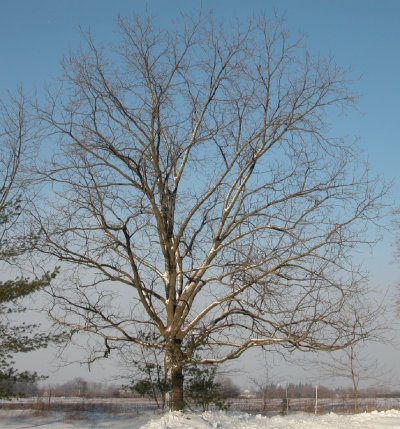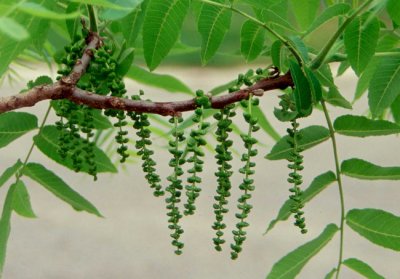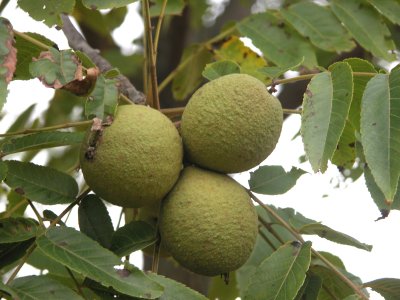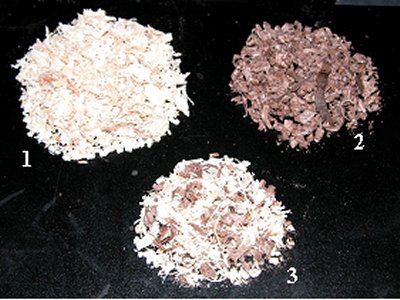Horses and black walnut shavings
Learn how to recognize and prevent black walnut toxicity in horses.
Introduction
Black walnut (Juglans nigra) and butternut (Juglans cineraria) are native to southwestern Ontario and the eastern USA. The greatest concern for horse owners is the presence of black walnut or butternut in the bedding material causing laminitis or founder in horses. Black walnut is highly prized for use in furniture. Therefore, shavings and sawdust from furniture factories, and sawmills processing black walnut, should not be used for horse bedding unless there is a way to keep the black walnut shavings separate from other shavings. Pollen of black walnut has been implicated in causing laminitis in horses
Toxicity
It is well known that juglone is produced by the members of the juglans species of trees. It is secreted through the roots to inhibit germination and growth of various species of plants that try to establish within the root zone of the tree. Researchers, however, have been unsuccessful in reproducing laminitis by applying either black walnut shavings or juglone to horses' feet. However, the ingestion by horses of aqueous extracts of heartwood consistently reproduces the laminitis syndrome
Fallen walnuts that have become moldy may contain the mycotoxin 'penitrem A', which is a neurotoxin capable of poisoning livestock and other animals, if ingested
Clinical syndrome
Laminitis (founder) is a painful disease of the foot. The horse often walks very tenderly and may stand with the front feet extended forward, shifting weight to the back feet. It is characterized by warm hooves, increased pulses to the feet and softening of the coronet. There may also be edema of the feet and legs. Altered blood flow in the foot leads to damage to the sensitive epidermal laminae, microvascular thrombosis, epithelial hyperplasia, and hemorrhage. Contact with black walnut shavings is one of a number of conditions that can result in laminitis. Others include: excessive exercise on hard surfaces, opposite-limb lameness, overfeeding, and a sudden change of diet to rapidly-growing grass. Laminitis is diagnosed by clinical signs, sensitivity to hoof testers and identification coffin bone rotation (third phalanx bone inside the hoof), as seen on radiology or MRI.
In the case of black-walnut-shavings exposure, clinical signs of laminitis typically occur within one to two days of exposure to fresh shavings from both new and old wood, but not aged shavings
Treatment
- Prompt removal of the offending shavings from the stall often alleviates the problem.
- Your veterinarian may prescribe supportive treatments including:
- Pain relief, in the form of non-steroidal, anti-inflammatory agents (NSAIDS), such as phenylbutazone or flunixin meglumine (Banamine®), is important.
- Washing the horse's legs to reduce any further absorption of toxin. This has been used extensively in the past but may be unnecessary based on the oral ingestion theory. However, it will do no harm.
- Cold-hosing or standing in cold water/ice baths to reduce inflammation and pain. This is used for the acute conditions 1-24 hours post exposure. Treatment consists of cycling between cooling of the legs and feet for half an hour, followed by allowing them to warm up for half an hour. This is useful in reducing the acute inflammation.
- Newer drugs such as adrenergic blockers (prazosin) and calcium channel blockers (nifedipine) appear promising
footnote 2 .
Identifying black walnut
Walnut and butternut trees are similar in appearance, are medium sized (up to 30 metres high), with a trunk diameter of up to 120 centimetres. They can live to 150 years. They have a straight trunk with a rounded open crown and few large ascending branches. (Figure 1) The roots are deep, wide-spreading and there is usually a taproot.

The leaves are compound leaves, having 7 to 11 opposite pairs of short-stalked leaflets on a moderately stout central stalk. A single terminal leaflet, smaller than the leaflet pairs, may or may not be present at the end of the stalk. Male flowers or catkins emerge in early spring releasing pollen (Figure 2).

Fruit of black walnut are 4 to 6 centimetres in diameter, green and rounded, hanging in drooping clusters of 1 to 3 nuts (Figure 3). Fruit of butternut are elongated or pointed at one end. Otherwise, they are similar in growth habit to walnut. An outer husk one half to 1 centimetre thick, covers the inner hard nut shell. Inside the husk, the nut is 3 to 4 centimetres in diameter. Nuts of black walnut are rounded, while nuts of butternut are elongated and pointed at one end.


General comments
Black walnut and butternut shavings should never be used for bedding material for horses. If there is no other choice, then the shavings should be stockpiled for several months and allowed to age before using.
Horse owners should:
- be very careful when purchasing or being given shavings from unknown sources
- ensure that the leaves, branches and fruit of walnut and butternut trees are not placed on the manure pile where horses can reach them
- ensure that the fallen leaves, fruit and branches of standing trees are not allowed to enter into horse paddocks by fencing the trees off to a distance that extends beyond the widest branches of the black walnuts and butternuts
J.L. Farrar's Trees in Canada
Further information on plant poisonings can be obtained from the Canadian Poisonous Plants Information System at the internet address listed below:
- Munro Derek B. Canadian Poisonous Plants Information System
Footnotes
- footnote[1] Back to paragraph MacDaniels LH. Perspective on the black walnut toxicity problem - apparent allergies to man and horse. Cornell Vet. 1983; 73 (2,Apr): 204-207.
- footnote[2] Back to paragraph Burrows GE, Tyril RJ. Toxic Plants of North America. Ames, Iowa: Iowa State Press, 2001: 725-728.
- footnote[3] Back to paragraph Knight AP, Walter RG. A Guide to Plant Poisoning of Animals in North America. Jackson, Wyoming: Teton New Media, 2001: 301-302.
- footnote[4] Back to paragraph Farrar JL. Trees in Canada. Fitzhenry & Whiteside Limited, 1995. ISBN 1-55041-199-3
- footnote[5] Back to paragraph Kershaw L. Trees of Ontario. Edmonton, Alberta: Lone Pine Publishing, 2001.